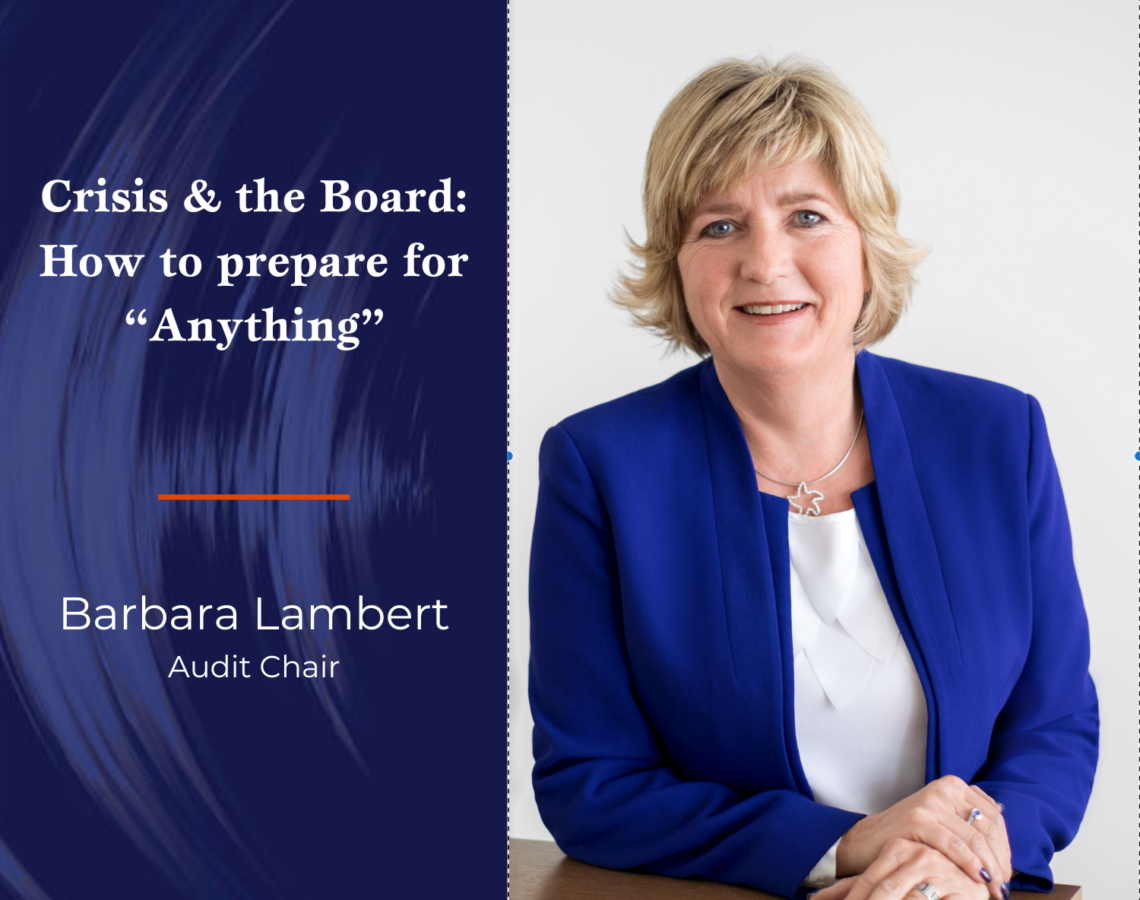Crisis & the Board: How to prepare for “Anything”

There are many different types of crises, and how boards deal with them, so it is prudent to be aware of typical mistakes, what works, and what boards can do to deal well with these situations. Barbara Lambert has developed some ‘golden rules’ that can serve as a starting point to prepare a board and ensure effectiveness and performance in a crisis.
In this podcast, Dr Sabine Dembkowski, Founder and Managing Partner of Better Boards, discusses crisis and the board with Barbara Lambert, a professional Board Member who chairs or is a member of the Audit, Risk and Nomination Committees. Her current and past mandates include Banque Pictet & Cie SA, Deutsche Börse AG, Implenia AG, Merck KgaA, Synlab AG and UBS Switzerland. Barbara spent 20 years at Arthur Andersen/Ernst & Young as a senior partner and Head of the Audit practice for banks and insurance. Between 2008 and 2018, she started as Head of Internal Audit at Pictet Group in Geneva and became a member of the Management Board as Group Chief Risk Officer.
“A crisis coming from external events has more often a greater speed… and internal crises are more likely to be hidden and evolve gradually”
Barbara reflects on her extensive experience managing crises over four decades, having identified clear patterns that emerge in such situations. Some crises, such as the Coronavirus pandemic, stem from global events that affect everyone, although their impact varies depending on the industry or the global reach of an organisation. Others, such as cyberattacks or the #MeToo scandals, may originate from widespread issues but hit certain companies harder, often leading to leadership changes. Then, some crises are entirely self-inflicted, including financial fraud, greenwashing, or serious product failures. These tend to highlight governance and risk management weaknesses.
Barbara notes crises are often categorised as predictable, looming, or unpredictable. However, these distinctions have become increasingly blurred, with events such as the Ukraine war, political unrest, or natural disasters challenging the boundaries of these definitions. Externally driven crises often unfold faster, while internal crises evolve more slowly, sometimes remaining hidden until they escalate. Cases like Dieselgate illustrate how crises can come in waves, gaining traction over time as media and public attention intensify. Despite these differences, she believes all crises share one fundamental trait – their potential to cause widespread damage and inevitable financial loss, reputational harm, and impact on stakeholders (including shareholders, employees, and clients). Poorly managed crises can spiral into brand damage, major reputational crises, or even bankruptcy, and managing them effectively from the outset is critical to mitigating these risks.
“I wish it was really a once-in-a-lifetime experience”
Barbara describes one of the most critical mistakes she has witnessed boards make during a crisis – underestimating the situation. Overconfidence often leads to a dangerous mindset of “this cannot happen to us,” resulting in a failure to engage in proper scenario planning or not considering worst-case scenarios. In these instances, communication tends to be inadequate, too little, too late, and lacking transparency, setting off a chain reaction. Without control of internal or external communication, rumours begin to spread, and the first to leave are often clients, followed by key personnel. What starts as a manageable issue can quickly snowball into an uncontrollable avalanche. Barbara cites the collapse of Arthur Andersen, her former employer, where what began as a crisis ultimately ended with the company’s demise. Having lived through this firsthand, Barbara is committed to proactive planning, clear communication, and decisive action, whether as an executive or a board member.
She believes boards in crises must adapt to the increasing speed, unpredictability, and interconnected nature of today’s challenges, which create a “toxic cocktail” of uncertainties. In this environment, Barbara outlines a threefold responsibility for boards. First is prevention, so boards must ensure robust risk management and crisis prevention strategies are in place. Second, support. During a crisis, boards should actively back management, providing resources, guidance, and oversight. Third, post-crisis analysis is needed when boards should conduct a thorough review of their own company’s response and how others managed similar situations. This “lessons learned” approach helps refine strategies and reinforces the commitment to proactive governance.
“It starts before the crisis, so the board should know where the company is vulnerable”
Drawing on nearly 40 years of experience in crisis management, Barbara outlines the key practices she has seen boards adopt to navigate crises effectively. Success begins long before a crisis occurs, with boards identifying vulnerabilities and ensuring regular, comprehensive updates on the company’s risk profile. These should cover financial and non-financial risks, including geopolitical issues, and happen at least twice a year, more frequently in highly regulated sectors. She highlights the value of an early warning system, such as a dashboard providing insights into liquidity, cash flow, inventory levels, IT stability, and customer or supplier dependencies. Internal power struggles or inconsistent public messaging during a crisis can be catastrophic, so tensions should be addressed and resolved early, as it is too late to mend divisions once a crisis hits. According to Barbara, a well-prepared, united board can make the difference between crisis recovery and failure.
Preparation is another critical component, and Barbara advises boards to conduct scenario-based exercises, from cyberattacks to energy outages, and to ensure essential but vital steps, such as distributing complete contact lists for board members, management, and key external advisors. During a crisis, she recommends forming a small, efficient task force comprising the chair or vice chair, a few senior board members with relevant expertise, and individuals based in the same time zone for better coordination. She highlights the importance of support from a strong corporate secretary’s office and external experts like forensic teams, lawyers, and auditors. Communication remains critical, both internally and externally, and employees, clients, and regulators should all receive timely and transparent updates, ensuring no one learns about developments from the media first. The company must designate one voice to speak on its behalf. In some cases, the CEO or chair may need to step in, particularly on social media, where their actions can have a profound positive or negative impact. Still, they need experience handling such platforms effectively to avoid overuse or poorly thought-out responses. The golden rule, she emphasises, is never to lie. No matter how understandable in the face of unfair criticism, emotional reactions should be kept private. Acting too quickly without full context can backfire, as can overreacting to rumours. In some situations, proactive communication helps maintain control, while staying silent may be the better choice in others. She notes that public apologies are often expected, especially in the US. Still, they must be authentic, accompanied by concrete measures to rectify the situation and show that lessons have been learned. In some cases, this may even involve dismissing individuals from senior leadership positions, demonstrating accountability and a commitment to real change.
“I think that there’s no miracle, but there’s just a solution”
Barbara acknowledges that preparing for crises amidst packed agendas is challenging but insists that the solution lies in prioritising time. Today’s board roles demand significant commitment—in reading documents and engaging deeply with strategic discussions, management, and fellow board members. She highlights how the role of a board member has evolved into a full-time commitment, where hard skills are critical, particularly in understanding emerging risks and opportunities driven by trends like data protection, ESG standards, artificial intelligence, quantum computing, and regulatory developments. Keeping pace with competitors and staying ahead of these challenges necessitates proactive training to help boards identify blind spots and effectively challenge risk reports. Traditionally updated every three to five years, strategic planning now requires annual reviews due to the rapidly changing and uncertain world. Barbara strongly advocates scenario-based crisis exercises, calling them a “necessary eye-opener.” These simulations not only build confidence in a company’s preparedness but also reveal critical areas for improvement. With so many looming risks, she urges boards to act sooner rather than later.
“Often the corporate strategy is not reflected in the board documentation, let alone the sustainability strategy.”
The three top takeaways for effective boards from our conversation are:
- Crisis management starts before the crisis, so as a board member, you must ensure that the company is prepared with scenarios, contingency plans and a robust risk management framework.
- Do not overestimate your availability before you accept a new or additional mandate. Decide honestly if you would really have the time to do it, and also carefully apply due diligence on the company’s strategic, financial, operational, and overall situation, the quality of the management, and willingness to change before you accept a new mandate.
- Crises and challenges are here to stay because of the current economic, technological and geopolitical environment. As a board member, you need to show that you can be the solid rock to whom executive management can turn for advice and spread the message that the crisis can be a productive state if well managed, even making a company stronger afterwards.
Remember to subscribe and never miss an episode of the Better Boards Podcast Series. It’s available on Apple, Spotify, or Google.
To find out how you can participate in the Better Boards Podcast Series or for more information on Better Boards’ solutions, please email us at info@better-boards.com.



